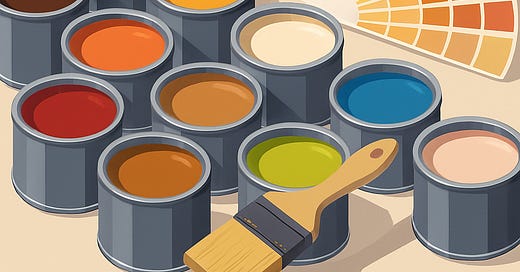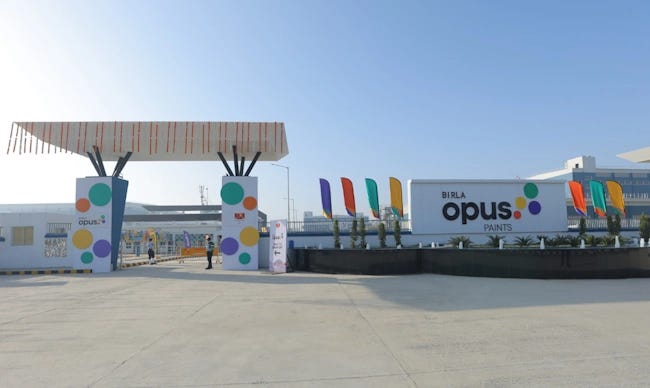The Great Indian Paint Shake-up
Established giants face unprecedented competition and strategic realignments in a transforming market
The Indian paints industry, long a bastion of steady growth and stable leadership, is in the midst of its most dramatic shakeup in decades, witnessing a fierce battle for market dominance and a realignment of industry titans. This turbulent period is marked by aggressive acquisitions, intense competition, and heightened regulatory scrutiny.
The Seismic Shifts: JSW's Bold Play & CCI's Gaze
The unfolding saga in the Indian paint industry can be traced back to a series of audacious moves and strategic responses.
A major development recently was JSW Paints Ltd.'s acquisition of a controlling 75% stake in Akzo Nobel India Ltd. for ₹9,000 crore. This strategic move brings established brands like Dulux and Sikkens under the JSW umbrella, signaling JSW's ambition to become a formidable force in the sector.
Almost concurrently, the industry leader, Asian Paints Ltd., found itself under the scrutiny of India’s competition watchdog, the Competition Commission of India (CCI). The CCI ordered an investigation into Asian Paints for allegedly abusing its dominant position in the decorative paints market.
This probe was spurred by a complaint from Grasim Industries, which recently entered the market with its Birla Opus Paints. Grasim alleged that Asian Paints imposed unfair conditions on its dealers, preventing them from collaborating with rivals like Birla Opus, and offered incentives such as foreign travel for exclusivity.
This isn't Asian Paints' first brush with such allegations; JSW Paints had made a similar complaint in 2020, though the CCI found no wrongdoing after a two-year investigation.
Beyond these headline-grabbing events, other major conglomerates have also thrown their hats into the ring, further intensifying the competitive landscape. These include Pidilite Industries with Haisha Paints, Astral acquiring Gem Paints, and JK Cements acquiring Acro Paints, collectively contributing to the sector's proliferation.
The Canvas of the Indian Paints Market
The Indian paints and coatings market was valued at ~$14 billion in 2024 and is projected to increase to $30+ billion by 2032 (ICICI Direct, 2024).
The sector is split roughly 75% decorative paints (used in homes and buildings) and 25% industrial paints (for automotive, infrastructure, and manufacturing).
Historically, the market has been concentrated among a few major players. However, recent years have seen a dramatic shift.
While Asian Paints held a significant 59% market share in 2023, its dominance has been challenged. The last two years have seen Asian Paints’ share dip (3-4%) as new entrants and aggressive expansions by existing players have put pressure on both margins and distribution
The industry's revenue growth slowed to 4% in FY24 from a CAGR of 14-15% between FY19-FY23, primarily due to price cuts, despite robust volume growth exceeding 10%.
The market faced subdued demand, particularly in urban areas, and intense price competition in FY25, though a modest recovery is anticipated in FY26.
The entry of Birla Opus and the JSW-Akzo deal mark a new phase of consolidation and competition, with all major players ramping up investments in capacity, branding, and dealer networks.
JSW's Strategic Brushstroke: The AkzoNobel Acquisition
In June 2025, JSW Paints announced the acquisition of a 74.76% stake in Akzo Nobel India for ₹9,000 crore, bringing iconic brands like Dulux and Sikkens under its umbrella.
The acquisition, subject to regulatory approvals and a mandatory open offer for minority shareholders at a premium, vaults JSW into the top tier of the industry, as it poised to become India’s fourth largest paint company with a combined revenue of ₹6,000 crore in FY25.
JSW's rationale for this aggressive move is multi-faceted. The company aims for the coveted No. 3 slot in the industry, seeing immediate profitability from day one without the need to burn cash.
The acquisition offers complementary strengths:
Akzo's premium Dulux brand complements JSW's mass-market offerings.
This synergy is expected to boost their combined dealer network to 27,000 (with Akzo’s 22,000+ dealer points), significantly increasing their reach.
JSW also targets overtaking Kansai Nerolac and achieving ₹10,000 crore in annual revenue, along with becoming the top player in industrial paints where they are already second-largest.
The possibility of a reverse merger exists, allowing JSW to go public without the complexities of an Initial Public Offering (IPO).
AkzoNobel's negligible long-term debt ensures the acquisition won't burden JSW significantly, with funding primarily from the JSW Group's books.
For AkzoNobel, the sale signals a recognition that it struggled to provide the necessary attention to its Indian operations to remain competitive.
While divesting its decorative paints business, AkzoNobel will retain its powder coating segment and commit to a technological partnership for liquid coatings.
For AkzoNobel shareholders, JSW has announced an open offer for the remaining 25.24% stake at ₹3,418 per share, a 23.8% premium over the stake sale price. This move may also open doors for JSW to make more acquisitions of smaller players via equity swaps post-listing to comply with public shareholding norms.
Birla Opus: The Disruptor's Arrival
The entry of Birla Opus Paints by Grasim Industries in February 2024 has undeniably acted as a major disruptor, injecting unprecedented competition into the sector, forcing incumbents to re-examine pricing, dealer incentives, and distribution strategies
Aditya Birla Group pledged a massive ₹10,000 crore investment in six greenfield plants, signaling its intent to enter the top tier of India’s paints industry and aiming for ₹10,000 crore in revenue within three years of full-scale operations.
Birla Opus has made significant strides in its first year—
Clocking revenues of around ₹2,500+ crores and grabbing a single-digit market share in Q4 FY25
Became a top five decorative paint brand within six months of its nationwide launch.
Leveraging Grasim's existing cement business, Birla Opus can tap into an extensive network of 200,000+ dealers across India, having already built the country’s second-largest depot network with 50,000 dealers, surpassing many older players.
The brand's strategy has involved aggressively wooing dealers with attractive margins and recruiting senior managers from rival firms, notably Asian Paints, further intensifying competition and sparking concerns of a looming price war.
Asian Paints: Navigating the Storm
Long the undisputed monarch of the Indian paints industry, Asian Paints is now navigating its most challenging period yet.
The recent sale of a 4.9% stake by Reliance, held for 17 years, for approximately ₹11,000 crore (a 24x return) via block deals reflects both, a maturing investment and the changing competitive landscape.
Asian Paints faces intensified competition, particularly from new entrants like Birla Opus and JSW Paints. This has led to a loss of market share from 59% down to ~54%.
The fierce competition has put immense pressure on its margins, forcing the company to increase spending on advertising and dealer commissions. This competitive pressure, coupled with weak urban demand, resulted in a ~6% decline in value for its decorative paints business in FY25 despite a 3% volume growth.
The ongoing CCI investigation adds another layer of regulatory oversight, reflecting the heightened scrutiny on its market practices.
Furthermore, fluctuating raw material costs, particularly for titanium dioxide (TiO2) and crude oil derivatives, continue to impact profitability.
Despite these formidable headwinds, Asian Paints' inherent strengths provide a robust foundation for resilience.
It remains financially sound, with its industry-best margins, strong cash flows, and a robust balance sheet.
The company still commands 50%+ of the paints and varnish space and it boasts unmatched dealer network (over 75,000 points), deep rural penetration and 1.6 lakh retail touchpoints.
Asian Paints continues to leverage its strong product innovation and deep understanding of Indian households. To navigate the current challenges, Asian Paints is strategically focusing on:
A "total home solution" approach, launching "Experience Stores" and home painting services, and expanding into adjacencies like waterproofing, furniture, kitchenware, and home décor.
The company is also investing in sustainable paints and has increased its capex, dealer networks, and advertising spending to defend its market share.
Other Key Players: Adapting and Growing
The increased competition is also prompting other established players to redefine their strategies and market positions:
Berger Paints India Ltd. is the second-largest player in the Indian paint market, holding around 15% -18% market share.
Known for innovation and steady growth, Berger took a different approach by focusing on premium products and raising prices, which helped it gain share
Kansai Nerolac Paints Ltd. trails with about 12%-15% market share. It is a leader in industrial paints (especially automotive).
Kansai Nerolac is strategically leaning on its industrial paints segment to offset the weak demand in the decorative segment.
Indigo Paints, a relatively newer entrant, Indigo has grown rapidly through strong branding, and is now a potential acquisition target as the sector consolidates.
The Indian paints sector is in a state of dynamic flux, with new entrants and aggressive strategies forcing incumbents to innovate and adapt.
While challenges like intense pricing pressure and shifting consumer preferences are evident, the long-term growth drivers like urbanization, rising disposable incomes, and government initiatives continue to be tailwinds for the industry's future.
For investors and industry watchers, the next few years promise to be as colourful—and unpredictable—as the paints themselves.











